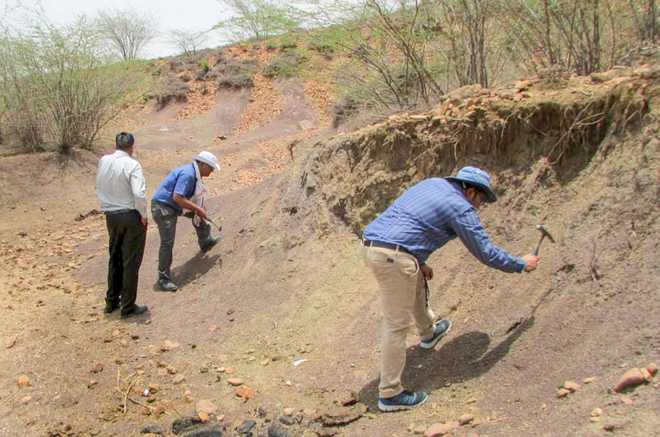Ramgarh crater in Rajasthan caused by meteorite impact, claim experts
Baran (Rajasthan), June 9
Since the 19th century, Ramgarh crater has evoked the interest of geologists and now a team of scientists is in Rajasthan's Baran district to solve the mystery of its origin and believes it has evidence to prove it was caused by meteorite impact.
With a diameter of 3.2-km and elevation of more than 200 metre above the surrounding terrain, it was first discovered by the Geological Survey of India in 1869. Nearly a century later in 1960, it was recognised as a 'Crater' by the Geological Society of London.
A four-member team from Geological Survey of India and National Trust for Art and Culture Heritage central office, New Delhi, visited the site yesterday to collect evidence related to the origin of the crater in Ramgarh village of the district.
"A huge meteorite of about 3 km diameter about 75,000 crore years ago is likely to have fallen here creating a trench of about 4 km diameter," Prof Vinod Agrawal of the team said today.
According to experts, there are two recognised craters in India - Lonar Lake in Buldhana district of Maharashtra and another in Shivpuri district of Madhya Pradesh.
"The centrally uplifted region of Ramgarh Crater is a live evidence of meteorite impact and is an ideal location as per well-established and internationally-approved criteria for meteorite presence," Agrawal said.
There are several other evidence in Ramgarh structure that will prove the meteorite impact theory, he added.
Pushpendra Singh Ranawat, geologists and coordinator of the team, said it was a very rare site in India and has got multi-faceted significance that include geo-heritage aspect.
"It is a general presumption that when something falls, it makes equal and opposite reaction and the centrally uplifted region of Ramgarh structure is an evidence of meteorite impact beyond challenge," Ranawat said.
He said the process for getting the structure recognised has been started and it is almost certain that Ramgarh Crater would soon get recognised by global agency in Canada as 191st crater in the world, third in India and first in Rajasthan.
Ranawat said a lot of research has been carried out at the site with collection of geochemical evidence, and field as well as laboratory evidence published in research papers and journals.
Once these evidence are approved by agency in India and by international agency, Ramgarh structure in Baran would be recognised as Crater of meteorite impact, he added.
"It would bring Baran as well as Rajasthan on the geological global map," Jiterndra Kumar Sharma of Baran INTACH chapter said.
He expressed confidence that Ramgarh Crater would certainly get recognition in world geological seminar scheduled to be held in 2020.
The team comprises senior geologist of GSI Abhishek Anand, Prof Vinod Agrawal of Mohan Lal Sukheriya University, geologists and coordinator of the team Pushpendra Singh Ranawat and N K Chouhan. They were accompanied by Baran INTACH chapter convener Jitendra Kumar Sharma. - PTI









